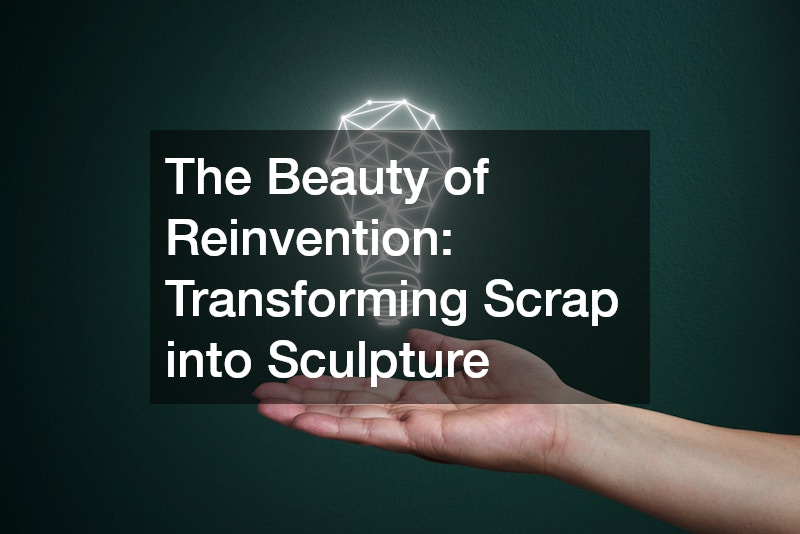Metal has long been a prized material in various fields due to its durability and versatility. Artists and designers have embraced metal, harnessing their fabrication skills to create everything from delicate jewelry to grand sculptures. As metal art gains popularity, creativity in using metal in new ways continues to evolve, inspiring both novice and experienced artists alike.
With an ever-growing emphasis on sustainability, artists are increasingly turning to salvaged and recycled materials as core components of their creations. Metal recycling companies have paved the way for artists to rethink materials, providing a wealth of possibilities for innovative design and craftsmanship. This article delves into the multifaceted world of metal art, exploring different avenues through which metal can be transformed from utilitarian material into artistic masterpieces.
In the following sections, we will discuss a range of metalworking techniques, sustainable practices, and educational opportunities for those looking to develop their fabrication skills. From finding resources in unexpected places to leveraging cutting-edge technology, the world of metal art is rich with opportunity. Let us embark on this journey to discover how creativity can elevate metal beyond its industrial roots.
Exploring the Versatility of Metal in Creative Projects

Metal’s versatility makes it an ideal medium for creative projects spanning various disciplines. Sheet metal fabrications can range from intricate, delicate forms to robust structural pieces, demonstrating the unique properties metal possesses. Artists with refined fabrication skills can manipulate metal into fluid, organic shapes or precision-engineered designs.
Exploring the realm of metalwork opens doors to innovative concepts and designs. From abstract sculptures to functional installations, the possibilities are limited only by the imagination. The beauty of metalwork lies in its ability to bridge the gap between aesthetic appeal and functional utility.
Local metal roof decking suppliers often provide material that is not only sturdy but also versatile for artistic solutions. Whether creating outdoor art installations or interior design elements, metal’s transformative potential continues to captivate artists and audiences alike. The intersection of art and industry is where innovation in metal artistry truly flourishes.
Breathing New Life into Salvaged Materials for Art
Salvaged metal provides a unique opportunity for artists to breathe new life into otherwise overlooked materials. Metal recycling companies are crucial partners in this process, offering a sustainable source of materials for artists looking to minimize their environmental impact. With keen fabrication skills, artists can transform metal scraps into art, giving these pieces narratives and new meanings.
Scrap metal recycling goes beyond environmental responsibility; it also stimulates creative expression. Artists who utilize salvaged materials often find that the journey of discovery is as rewarding as the final product. Each piece of metal carries a story that, when woven into broader artistic concepts, adds depth and intrigue to artworks.
Scrap yards are treasure troves for creative individuals keen on repurposing metal. These spaces offer a variety of materials, each with unique properties and characteristics ready for exploration through fabrication skills. By transforming what might be considered waste into compelling art, artists redefine aesthetic boundaries and challenge conventional art forms.
Hidden Gems: Finding Art Supplies in Unexpected Places

Creative individuals often discover artistic inspiration in the most unlikely settings. Steel supply warehouses often house materials that inspire unique, boundary-pushing creations. Artists frequent these establishments to source pieces that become central elements of their projects.
The search for unusual art supplies leads many to forge connections within their communities, including welding schools, which may offer unexpected resources. Educators and students collaborate on experiments that push the limits of traditional metalworking. Coupling these connections with exceptional fabrication skills, artists can uncover unique possibilities and assistance to realize their creative visions.
Metal recycling companies pave the way for the rejuvenation of seemingly ordinary materials. By fostering partnerships with these businesses, artists can access a broader spectrum of materials than they might find through conventional channels. This continuous search for hidden gems bolsters the metal art movement, demonstrating that beauty often lies in the unexpected.
Innovative Uses for Industrial-Grade Metal in Sculpture
Metal artists often look to industrial-grade metals for their solidity and structural integrity. These materials offer incredible possibilities for large-scale sculptures and public installations. With enhanced fabrication skills, artists can shape and form these robust metals into breathtaking works of art.
Industrial metals provide both a challenge and a canvas for creative exploration, demanding precision and expertise. Artists utilize advanced techniques and technologies such as robotic welding to achieve complex forms and elegant designs. Mastering these techniques not only expands an artist’s capabilities but also heightens the impact of their work.
The intersection of art and industry often yields innovative results, displaying metal’s versatility in diverse contexts. Sculptures created with industrial-grade materials can at once convey strength and subtlety, representing the harmony of functionality and artistry. The use of these metals contributes to a diverse creative landscape, enriching the dialogue around modern metal art.
Sustainable Practices in Modern Metal Art
Sustainability has grown in importance for artists, prompting a shift towards more environmentally responsible practices. One of the ways metal artists contribute to sustainability is by working primarily with recycled materials. This approach helps reduce waste while allowing artists to engage in meaningful creative processes using their fabrication skills.
Collaborations with metal recycling companies enable artists to access an array of materials while promoting ecological mindfulness. These partnerships facilitate a circular economy around metal, where scraps are reborn as art. The impact of sustainable practices resonates not only within the art community but also among audiences who appreciate the value of environmentally conscientious creations.
Through the incorporation of recycled and salvaged materials, metal artists craft stories of conservation and transformation. These narratives strengthen community bonds and promote awareness about the role of art in ecological discourse. By adopting sustainable practices, modern metal artists contribute positively to the global effort towards environmental stewardship.
Learning Precision: Education Paths for Aspiring Metal Artists

For those looking to hone their metalworking skills, a variety of educational paths are available. Welding schools offer programs that teach the intricacies of metal manipulation, encompassing techniques ranging from basic welding to advanced fabrication skills. These institutions equip students with the technical knowledge necessary to excel in the art of metalworking.
Higher education in metalsmithing and sculpture also allows for the exploration of artistic concepts alongside technical skills. Universities and art schools often offer specialized courses that merge creativity with precision, training future artists in both innovation and craftsmanship. These educational pathways support a comprehensive understanding of how to harness metal’s potential in art.
The learning journey for aspiring metal artists isn’t limited to formal education. Many benefit from apprenticeships and workshops, where they can learn directly from established artists and industry professionals. These experiences provide valuable insights into the practical application of fabrication skills and offer a supportive network for budding artists.
Sourcing Materials for Metal Art: A Creative Approach
Sourcing materials is a key aspect of the metal artistry process, and creativity plays a crucial role in this endeavor. Artists often frequent steel supply warehouses to find distinct materials that can enhance their projects. This exploration of resources not only fosters innovation but also deepens the connection between the artist and their medium.
A proactive approach to sourcing involves engaging with local businesses, like scrap yards and metal recycling companies, which can offer an abundance of supplies. By fostering strong relationships with these entities, artists gain access to materials that may otherwise be unavailable in traditional art supply stores. Through these partnerships, artists can utilize their fabrication skills to turn ordinary materials into exceptional art.
Artistic creativity in material sourcing is not just about availability but also about concept development. Artists often have conceptual ideas before seeking specific materials, guiding their choices based on the envisioned final product. This approach accentuates the role of imagination and planning in the metalworking process, ultimately elevating the work produced.
The Intersection of Technology and Craft in Metal Fabrication
The integration of technology into metalworking has revolutionized the field, expanding the creative possibilities available to artists. Robotic welding, for example, allows for precision and efficiency in creating intricate designs, enhancing the quality and scope of metal artworks. Advances in technology have become indispensable tools for those mastering their fabrication skills.
While technology introduces new capabilities, it also complements traditional craftsmanship. Artists who combine technological innovations with age-old techniques can push creative boundaries, producing works that are both groundbreaking and deeply rooted in tradition. This interplay between old and new enriches the dialogue surrounding modern metal art.
The technological landscape continues to evolve, ensuring that metal artists have access to tools that support their imaginative endeavors. As artists adopt technological advances, they must remain adaptable, continually learning new methodologies to refine their practices. This dynamic environment fosters perpetual growth and innovation in the world of metal art.
Flexibility and Functionality in Mobile Metalworking
The rise of mobile metalworking has offered increased flexibility for artists who require adaptable workspaces. Mobile welders can bring their fabrication skills directly to sites, enabling on-the-go creation and modification of metal art. This accessibility supports artists in responding swiftly to creative impulses and practical requirements.
Mobile welding services have broadened the scope of projects artists can undertake, allowing for direct collaboration and in-situ creation. By utilizing these portable solutions, artists can execute larger scale works with greater efficiency and convenience. This adaptability is crucial for those working on dynamic projects, where site-specific adjustments are often necessary.
The flexibility of mobile metalworking fosters collaboration between artists and clients, leading to more personalized and effective outcomes. By working directly in the environment where the art will be displayed, artists can ensure their work aligns with the intended space and purpose. This integration of functionality and creativity exemplifies the versatility inherent in modern metal artistry.
The Beauty of Reinvention: Transforming Scrap into Sculpture

The ability to transform scrap into compelling artwork is a testament to the ingenuity of metal artists. Artists skilled in fabrication often view scrap not as waste but as raw potential waiting to be uncovered. In this transformation, old metal gains new life, telling stories beyond its original use.
Scrap metal recycling has popularized the notion of reinvention within the art world, encouraging artists to see value in the discarded. This practice not only enriches the artistic narrative but also contributes to sustainability efforts. Through careful selection and skilled manipulation, what was once considered refuse becomes an extraordinary work of art.
The process of turning scrap into sculpture involves both creativity and craftsmanship. Artists must envision the potential within each piece, ensuring that their fabrication skills are employed to realize their vision. This practice celebrates transformation, highlighting the beauty that lies in every step of the recycling process.
Modern Techniques for Shaping Thin Metal into Art
Working with thin metal requires precision and advanced technique, as the material’s delicacy demands careful handling. Artists adept in fabrication skills excel in transforming thin metal into intricate designs, capturing elegance and fluidity in their artworks. Mastery of these techniques allows for the creation of pieces marked by both complexity and refinement.
Modern innovations in machinery and tools have expanded the possibilities for shaping thin metals into art. Laser cutting and CNC machines, for example, facilitate detailed work previously challenging to achieve by hand. These technological advancements support the pursuit of visionary metal art projects, empowering artists to refine their craft further.
Thin metal sculptures often exude a sense of lightness and grace, juxtaposing the material’s strength with visual softness. This aesthetic balance is achieved through meticulous planning and execution, underscoring the artist’s fabrication expertise. As techniques continue to advance, artists will keep pushing the limits of what is achievable with thin metal.
Drawing Inspiration from Functional Metal Structures
Functional metal structures often serve as a source of inspiration for artists looking to integrate utility and aesthetics. Metal roofing, for example, can invoke notions of protection, form, and stability, challenging artists to reimagine these elements in artistic contexts. By applying their fabrication skills, artists can reinterpret functional designs, blurring the lines between purpose and creativity.
The functionality inherent in structures like local metal roof decking further encourages artists to explore the relationship between design and utility. These practical applications of metal demonstrate its potential beyond aesthetic considerations, highlighting the dual nature of metalworking as both art and engineering. Through artistic reinterpretation, utility evolves into inspiration, driving creativity forward.
This dialogue between art and function offers a unique lens through which to view everyday structures. Artists can extract and expand upon the beauty present in functional items, transforming them into visionary works of art. Through this exploration, metal artists continue to push the boundaries of creative expression by drawing inspiration from the practical realities of metal structures.
Crafting Stories with Steel: From Utility to Artistry
Steel, with its strength and durability, offers a rich medium for artistic expression and storytelling. Artists utilizing their fabrication skills can craft narratives that reflect themes of resilience and transformation, infusing each piece with profound meaning. Steel’s duality as both a utilitarian and artistic material invites a deeper exploration of its potential as a messenger of stories.
The process of turning steel from a functional material into an artistic one often involves redefining its perceived roles. Artists may see steel as a canvas, utilizing both its form and substance to communicate complex concepts and emotions. This transformation is at the heart of the craft, lacing every creation with the artist’s voice and vision.
Through innovative methodologies and conceptual approaches, artists bring the innate qualities of steel into alignment with personal artistry. This synthesis of material and imagination results in pieces that transcend their physical properties, presenting stories that resonate with audiences. Crafting steel into art symbolizes a larger narrative of invention and meaning, enriching the artistic discourse.
The exploration of metal as an artistic medium highlights its immense potential for creativity and innovation. From the intricacies of fabrication skills to the sustainability of scrap metal recycling, artists are constantly pioneering new pathways to transform metal into art. The dialogue between technology, tradition, and resourcefulness shapes the foundation upon which modern metal artistry stands.
At the intersection of practical application and aesthetic expression, metal artists leverage their skills to turn cold steel into captivating narratives. By collaborating with metal recycling companies and leveraging evolving technologies, they champion new expressive forms, sustainable practices, and visionary artworks. This body of exploration paints a promising future for metal art, one in which utility and beauty continue to converge.
As the world of metal art evolves, it beckons the next generation of artists to step into the forge with fresh ideas and perspectives. With ongoing advancements in techniques and technology, the possibilities for creativity are boundless. In this burgeoning era of metal artistry, artists will continue to inspire, innovate, and astonish using the timeless medium of metal.




